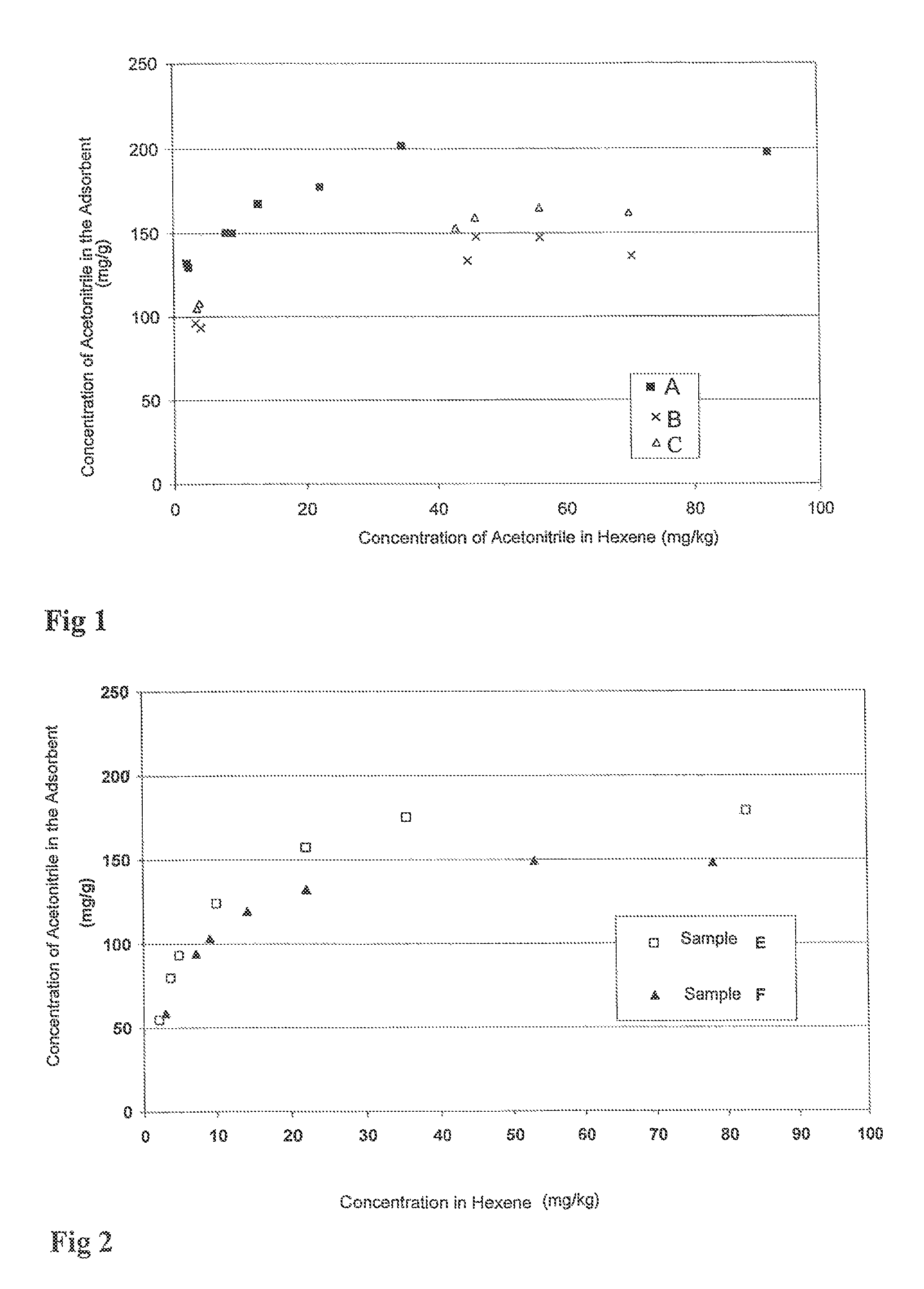Process for purification of olefinic feedstocks using an adsorbent comprising a 12 MR-type zeolite
a technology of olefinic feedstock and adsorbent, which is applied in the field of hydrocarbon purification, can solve the problems of adsorbents that can actually lose their adsorption capacity, impede the operation of a large number of industrial catalysts, and cannot be stable enough thermally
- Summary
- Abstract
- Description
- Claims
- Application Information
AI Technical Summary
Benefits of technology
Problems solved by technology
Method used
Image
Examples
example 1
Synthesis of Adsorbents A, B, C, and D
[0087]This example illustrates the reactivity of different adsorbents for the most part composed of the NaX zeolite: an adsorbent A according to the invention and two adsorbents B and C, not in accordance with the invention and representative of the prior art.
Synthesis of the Adsorbent A (According to the Invention):
a) Preparation of the Zeolite Powder:
[0088]A gel of molar composition 3.2 Na2O-2.8 SiO2-Al2O3-130 H2O is prepared by using the following reagents: soda silicate, sodium aluminate, and water. The gel is allowed to cure at 35° C. for 20 hours, and then crystallization is carried out for 4 hours at 100° C. Next, the powder containing zeolite crystals is filtered and washed. By XRD analysis, it is determined that these crystals belong to the faujasite family (FAU). The chemical analysis provides an Si / Al ratio=1.25+ / −0.03.
b) Agglomeration:
[0089]Next, this zeolite powder is agglomerated by mixing it thoroughly with Charentes kaolinite and...
example 2
Adsorption Capacity of Adsorbents A, B, and C
[0113]This example makes it possible to compare the adsorption capacities of the same samples as those defined in Example 1.
[0114]To do this, the samples are activated under nitrogen at 400° C. for 2 hours. Next, they are brought into contact in a flask (of the vial type according to the English term) with a hexene solution containing different concentrations of acetonitrile. Next, the flask is placed in a vibrating bath and thermostated at 30° C. for 24 hours. Next, the final acetonitrile content is analyzed by chromatography, which makes it possible to calculate by material balance the quantity of acetonitrile adsorbed in each of the adsorbents at different concentrations.
[0115]The results that are obtained are presented in FIG. 1.
[0116]FIG. 1 shows that the adsorption capacity of acetonitrile by the adsorbent A according to the invention is greater than that of adsorbents B and C according to the prior art. The adsorbent A according to...
example 3
Synthesis of Adsorbents E and F
[0117]This example shows that the reactivity of different adsorbents that are composed for the most part of KX zeolite: an adsorbent according to the invention and an adsorbent in accordance with the prior art [sic].
Synthesis of the Adsorbent E According to the Invention:
a) Preparation of the Zeolite Powder:
[0118]A gel with a molar composition of 3.2 Na2O-2.8 SiO2-Al2O3-130 H2O is prepared by using the following reagents: soda silicate, sodium aluminate, and water. The gel is allowed to cure at 35° C. for 20 hours, and then crystallization is performed for 4 hours at 100° C. Next, the crystals are filtered and washed. By XRD analysis, it is determined that these crystals belong to the family of faujasite (FAU). The chemical analysis provides an Si / Al ratio=1.25+ / −0.03.
b) Agglomeration:
[0119]Next, this zeolite powder is agglomerated by mixing it thoroughly with Charentes kaolinite and colloidal silica, with a ratio by mass of zeolite / kaolinite / silica of...
PUM
| Property | Measurement | Unit |
|---|---|---|
| size | aaaaa | aaaaa |
| temperatures | aaaaa | aaaaa |
| temperature | aaaaa | aaaaa |
Abstract
Description
Claims
Application Information
 Login to View More
Login to View More - R&D
- Intellectual Property
- Life Sciences
- Materials
- Tech Scout
- Unparalleled Data Quality
- Higher Quality Content
- 60% Fewer Hallucinations
Browse by: Latest US Patents, China's latest patents, Technical Efficacy Thesaurus, Application Domain, Technology Topic, Popular Technical Reports.
© 2025 PatSnap. All rights reserved.Legal|Privacy policy|Modern Slavery Act Transparency Statement|Sitemap|About US| Contact US: help@patsnap.com



